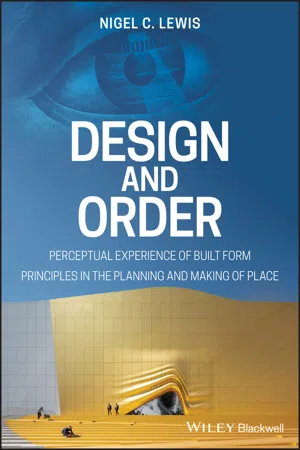
Design and Order
Perceptual Experience of Built Form - Principles in the Planning and Making of Place
- English
- ePUB (mobile friendly)
- Available on iOS & Android
Design and Order
Perceptual Experience of Built Form - Principles in the Planning and Making of Place
About This Book
Teaches the principles behind the successful planning and creation of inspired built forms and urban places
This book offers an integrated understanding of both the principles and the perception of the design of built environments and public spaces. It outlines the fundamental characteristics that are evident in the creation of built form and illustrates how they determine the experience of resultant places. It also consolidates the key criteria that need to be taken into consideration in the development of these areas. All of the above-mentioned aims to provide designers with a solid understanding of the implications of their decisions on perception and behavior during the creation of new spaces.
Design and Order: Perceptual experience of built form - Principles in the Planning and Making of Place starts by examining the designing of natural environments and the affect that they have on humans. It teaches readers how people experience and are shaped by a space—via their eyes, brain, and overall perception. It then instructs on proper grammar of form and syntax so that designers can understand how to pursue design processes systematically. The book then takes readers through this process of designing, informing them on the principles of form, function, configuration, communication, organization, color and contrasts, building structures, good practice and more.
- Seeks to improve the methodological approach to the planning and design of buildings
- Broadly address all of the functions that impact the realization of new built and urban form
- Outlines the fundamental characteristics that are evident in the design of built forms and illustrates how these characteristics determine the experience of the resultant places
- Comprehensively covers the ideas, principles, and the perception of design
- Teaches designers to make informed decisions about applying or discarding principles when creating spaces.
Design and Order is a unique book that will appeal to students and professionals in architecture, urban design and planning, as well as designers and developers.
Frequently asked questions
Information
Table of contents
- Cover
- Table of Contents
- Outline
- Preface
- Section I: The Environment
- Part I: The Environment – Natural, Ecological and Historical (Topography)
- Section II: Human Behaviour and Design
- Part II: Human Behaviour (Neuro‐Physiology)
- Part III: Perceptual Experience of Form (Psychology and Phenomenology)
- Part IV: Grammar and Syntax of Form, and Composition
- Part V: Planning and Design Process, and Programme Requirements (Methodology)
- Section III: Form, Function and Fit
- Part VI: Form and Fit
- Part VII: Building Structure and Types
- Section IV: Built and Urban Form
- Part VIII: ‘Good’ Practice – Built Form
- Part IX: ‘Good’ Practice – Urban Form
- Summary
- Bibliography
- Appendices – Part I
- Appendices – Part II
- Appendices – Part IV
- Appendices – Part V
- Appendices – Part VI
- Appendices – Part VIII
- Appendices – Part IX
- Index
- End User License Agreement